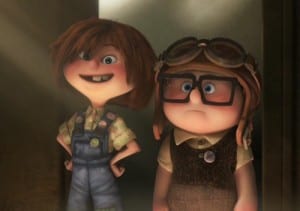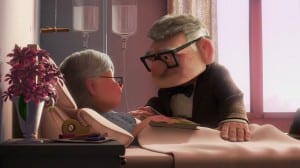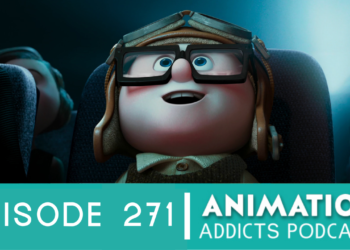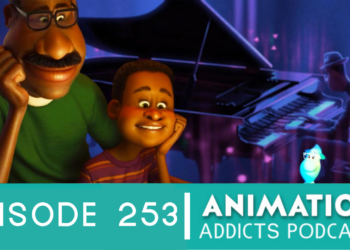 Film is a form of escapism. Audiences enter a movie theater hoping and expecting to be transported away from reality and into a realm of imagination, fantasy, and mystery that they cannot experience in the real world. That is not to say, though, that cinema should be a false perception of truth with no footing in accuracy. The difference between a good film and a great film is its ability to transcend the screen and allow audiences to see reflections of themselves in its characters and story. That is what pushes the product from being something much more than a series of successive images flashing across a canvas: that connection. A company continually responsible and counted on for giving moviegoers that intimate, resonate relationship through fantastic storytelling is Pixar Animation Studios. In its 2009 film, Up, through its signature pantomime opening sequence, the studio pushes the boundaries once more of how powerful animation can be. With Up‘s Pump-Up Week upon us (we’ve already dissected why it might be Pixar’s best feature) and its Animation Addicts podcast episode on the way this Friday, now is the perfect time to take a closer look at these iconic first few minutes of film.
Film is a form of escapism. Audiences enter a movie theater hoping and expecting to be transported away from reality and into a realm of imagination, fantasy, and mystery that they cannot experience in the real world. That is not to say, though, that cinema should be a false perception of truth with no footing in accuracy. The difference between a good film and a great film is its ability to transcend the screen and allow audiences to see reflections of themselves in its characters and story. That is what pushes the product from being something much more than a series of successive images flashing across a canvas: that connection. A company continually responsible and counted on for giving moviegoers that intimate, resonate relationship through fantastic storytelling is Pixar Animation Studios. In its 2009 film, Up, through its signature pantomime opening sequence, the studio pushes the boundaries once more of how powerful animation can be. With Up‘s Pump-Up Week upon us (we’ve already dissected why it might be Pixar’s best feature) and its Animation Addicts podcast episode on the way this Friday, now is the perfect time to take a closer look at these iconic first few minutes of film.
With this opening, Up immediately shatters the stereotype of animation being strictly for children. Director Pete Docter, who also helmed Pixar’s 2001 classic Monsters, Inc., led the film to not only achieve the Academy Award win for Best Animated Picture, but to also receive a nomination for Best Picture, something only done by one other animated film before it, 1991’s Beauty and the Beast. The reason is clear for Up’s unanimous acclaim in the first ten minutes of the film, showing young Carl Fredricksen’s fascination with exploration and his meeting a girl, Ellie, who shares this same interest, seguing into a five-minute scene presenting a montage of the pair’s shared life together, famously named “Married Life.”
 The most noticeable quality of this sequence is its ability to tell a self-contained story that spans nearly 60 years without ever using one line of dialogue. It utilizes music and visuals to tell its narrative, almost feeling like a short film in the silent era of animation, but with much more poetry than cartoons of that time would ever know to have. Michael Giacchino’s Oscar-winning score takes on the nostalgic sound of ragtime in the 1930s. It keeps a consistent melody throughout the entire segment that changes shape to match the stages of life and the circumstances Carl and Ellie experience throughout their marriage, its tune being bouncy and toe-tappable at some points, with brasses and strings whose sounds immediately recall a glorified version of a bygone time in history. At other moments, though, the music is very somber and beautifully slow, helped by the simplicity of its arrangement with instruments like a single piano.
The most noticeable quality of this sequence is its ability to tell a self-contained story that spans nearly 60 years without ever using one line of dialogue. It utilizes music and visuals to tell its narrative, almost feeling like a short film in the silent era of animation, but with much more poetry than cartoons of that time would ever know to have. Michael Giacchino’s Oscar-winning score takes on the nostalgic sound of ragtime in the 1930s. It keeps a consistent melody throughout the entire segment that changes shape to match the stages of life and the circumstances Carl and Ellie experience throughout their marriage, its tune being bouncy and toe-tappable at some points, with brasses and strings whose sounds immediately recall a glorified version of a bygone time in history. At other moments, though, the music is very somber and beautifully slow, helped by the simplicity of its arrangement with instruments like a single piano.
The audience soon realizes that this story, or at least this particular slice of it, does not end happily and that Carl and Ellie’s dream vacation will never happen in the way they hoped. In a smart pan shot, the camera moves from Carl and Ellie happily decorating a bedroom nursery for an expected baby to a successive shot in a hospital room, Ellie on her knees with her face in her palms, Carl consoling her, and a doctor standing above them. The concept implied is a miscarriage. This slap in the face of life’s harsh actualities immediately evokes a shift in audience perception. With that simple move of the pan shot, Pixar sends the message to the audience that this film is not children’s fodder. It is a movie that can entertain children, yes, but it is much more than a babysitter that animated films are so often reduced to being. It is not afraid to take its characters across boundaries the audience does not expect them to cross. Carl and Ellie radiate with inexpressible joy at the upcoming arrival of their child, only to have the rug swiped from underneath their feet in an instant. A similar approach set the tone for the opening moments of Pixar’s 2003 film, Finding Nemo, in which a barracuda attack leaves a father clownfish without a wife and left with only one of his dozens of eggs. It establishes the expectation for the film straightforwardly: not one that is wholly and completely depressing, but one that does not ignore the difficult parts of life and the emotions that come with those hard experiences.
As the images of Carl and Ellie’s highs and lows play across the screen, their emotional resonance is aided by superb animation. The effectiveness here comes in the subtlety of Carl and Ellie’s performances. The deflated sorrow in Ellie’s face as she sits ethereally outside following the news of her miscarriage does not need any exaggerated, sweeping motion to get the point across of how she feels. The couple’s reactions to each other as they interact in activities like cloud-watching convey their communication louder than voice acting ever could. The audience knows the exact dynamic of the special, symbiotic relationship Carl and Ellie have with one another thanks to utmost attention to detail on the animators’ part and their reservations to not make the characters’ movements traditionally broad or cartoony.
 And with old age comes, inevitably, death. With the miscarriage just shown, the audience knows that the filmmakers do not shy away from concepts potentially saddening or even morbid. So when the camera comes to an obviously ill Ellie in a hospital bed, holding hands with Carl, everyone viewing the film probably has an idea of what will happen next. Instead of surprise, the reaction is a feeling of uneasiness much like what might be felt at the loss of someone known in real life. The audience was just introduced to this character not ten minutes ago, yet already at the idea of her death there is definite unsettlement. At the beginning of this sequence, moviegoers are enthralled with the idea of a cute, flighty, quirky romance. By its conclusion, the perspective has transitioned into a heavy bond with the display of an authentic relationship with surprising depth.
And with old age comes, inevitably, death. With the miscarriage just shown, the audience knows that the filmmakers do not shy away from concepts potentially saddening or even morbid. So when the camera comes to an obviously ill Ellie in a hospital bed, holding hands with Carl, everyone viewing the film probably has an idea of what will happen next. Instead of surprise, the reaction is a feeling of uneasiness much like what might be felt at the loss of someone known in real life. The audience was just introduced to this character not ten minutes ago, yet already at the idea of her death there is definite unsettlement. At the beginning of this sequence, moviegoers are enthralled with the idea of a cute, flighty, quirky romance. By its conclusion, the perspective has transitioned into a heavy bond with the display of an authentic relationship with surprising depth.
Perhaps the most important purpose of the “Married Life” sequence is the ground it establishes for the rest of the film. With Ellie in his life, Carl is enthusiastic, encouraging, and lively. His personality distinctly changes following her death into a curmudgeonly, disgruntled man who only cares for himself and struggles to move forward without the presence of his wife. If the film had thrust the audience directly into the story at the point immediately following the “Married Life” sequence, moviegoers would have a very different attitude toward Carl. They would not be sympathetic and would instead view his outlook on the world as illegitimate, unwarranted, and selfish. What “Married Life” succeeds at, then, is giving the audience a reason to be on Carl’s side. After grasping an understanding of the fullness of life he felt with Ellie by his side, and then seeing her quickly taken out of the picture, there is able to be a sense of authenticity. There can be empathy toward Carl now—not just pity for what he lost, but encouragement for him to find his spirit of adventure again. As the scene concludes with Carl sitting alone in a dark church presumably following Ellie’s funeral and the screen fades out to black, that is what the audience feels most potently. That is what propels the remainder of the film forward.
The weight of the entire film rests on those five minutes of expert use of music and animation magic. It does what Pixar does best and continues to redefine what an animated film can and should be. Through its simplicity, it becomes a sequence that embodies the brilliance of the film to follow: one with inventive humor that evokes laughter, compelling characters who evoke relatable connections, and a resonate message that evokes a reminder that life can always be an adventure if approached with a holistic attitude willing to share it with others.







![[DVD REVIEW] Transformers: Energon – THE COMPLETE SERIES](https://www.rotoscopers.com/wp-content/uploads/2014/05/1097888412.jpg)